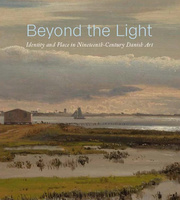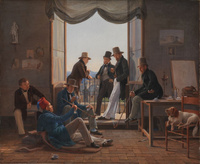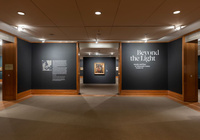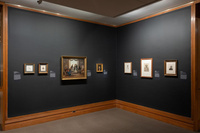Beyond the Light: Identity and Place in Nineteenth-Century Danish Art
Reviewed by Tonje Haugland SørensenTonje Haugland Sørensen, PhD
Senior research fellow
University of Bergen
Department of Linguistic, Literary and Aesthetic Studies
Email the author: onje.sorensen[at]uib.no
Citation: Tonje Haugland Sørensen, exhibition review of Beyond the Light: Identity and Place in Nineteenth-Century Danish Art, Nineteenth-Century Art Worldwide 22, no. 2 (Autumn 2023), https://doi.org/10.29411/ncaw.2023.22.2.22.
This work is licensed under a Creative Commons Attribution-NonCommercial 4.0 International License  unless otherwise noted.
unless otherwise noted.
Your browser will either open the file, download it to a folder, or display a dialog with options.

Beyond the Light: Identity and Place in Nineteenth-Century Danish Art
The Metropolitan Museum of Art, New York
January 26–April 16, 2023
Catalogue:
Freyda Spira, Stephanie Schrader, and Thomas Lederballe, eds.,
Beyond the Light: Identity and Place in Nineteenth-Century Danish Art.
New York: The Metropolitan Museum of Art, 2023.
227 pp.; 97 color illus.; notes; selected readings; acknowledgements; index.
$50 (hardcover)
ISBN: 9781588397331

In 1837 the Danish painter Constantin Hansen (1804–80) completed a work showing seven men lounging in a room (fig. 1). Three of them are standing on a brightly lit porch while the other four have moved to the more shadowy interior, where one is sitting on a table, his feet dangling, and another lies on the floor on a heap of carpets and pillows. The men are smoking, gesticulating, and enjoying whatever beverage was in the small, white, and fragile porcelain cups on the table and floors. They seem unconcerned with the bright vista glimpsed through the window. They are equally uninterested in a small dog curled up on a chair on the right. Instead, the men seem entirely preoccupied with each other and what appears to be a solemn conversation. No wonder then that several scholars through the years have tried to determine what exactly the men are talking about. The title of the painting gives some clues in that direction. The work is known as A Group of Danish Artists in Rome, and all the men in the painting are identifiable as well-known Danish painters and architects from this period. Would it not then be logical that they are discussing art? Perhaps even Danish art and what that entails? It is an enticing thought because these artists were central in establishing Denmark’s current art historical canon.
Hansen’s work came about partially as a result of a request from the Kunstforeningen (Society of Art) in Copenhagen to six Danish artists living abroad to send a painting with a subject of their own choosing.[1] This was Hansen’s submission, and it has since become one of the central works of Danish art from the years between 1800 and 1850, a period often referred to as the Golden Age of Danish painting. Presently the work is in the exhibition Beyond the Light: Identity and Place in Nineteenth-Century Danish Art, organized by the Statens Museum for Kunst (SMK) in collaboration with the Metropolitan Museum of Art and the J. Paul Getty Museum (fig. 2). There it is joined by a selection of works from all three museums, but with a particular emphasis on the collection of the SMK (fig. 3). Some of these works are similarly well-known, while many of them are sketches and drawings not usually exhibited. A visit to the exhibition therefore allows visitors to become acquainted with works not usually found outside museum storage facilities.


The result is an exhibition that rewards close reading of the many gorgeous sketches of palaces, cityscapes, landscapes, and views from an artist’s window. There is also an emphasis on the relationship between the burgeoning natural sciences and their influence on art. It is also an exhibition that—at least in part—opens up reflections on the mechanics of drawing. This is fitting, as how to draw and what to draw were matters of artistic debate in the Danish art world of this period, and it is easy to imagine sessions like the one depicted by Hansen devoted to the topic and recurring frequently wherever Danish artists were gathered. Formative figures like the artist Christian Wilhelm Eckersberg (1783–1853) became greatly influential in their call for the use of perspective to create harmonious scenes brimming with verisimilitude. Several of Eckersberg’s works are included in the exhibition alongside some of his pedagogical publications on the topic. Moreover, this was an attitude that Eckersberg, in his role as professor at the Academy of Fine Arts, imprinted upon his students—several of whom are depicted in Hansen’s painting. In fact, Hansen himself was an avid follower of Eckersberg and once advised his daughter Elise to draw a lopsided jar not as lopsided but rather “as it would have looked in Paradise” (31). Apparently, in Hansen’s version of paradise all jars were straight. The anecdote, dwelt upon by Thomas Lederballe in the accompanying catalogue, hints at an issue underlying several of the artworks in the exhibition. Many can at first glance be taken as meticulous accounts of everyday life. Many are associated with travel and give the impression that they are records of what the artists saw. If so, it is worth recalling that this was in part a highly stylized and idealized world wherein the place afforded lopsided jars was limited.
This creation of a seemingly serene world is touched upon by several of the authors in the catalogue. Freyda Spira, for example, notes in her essay, entitled “Denmark and the Sea,” that Eckersberg’s The Harbor of Copenhagen, Esplanade between Langelinie Park and Toldboden, or the Customs House from 1809 depicts a peaceful harbor filled with ships. This, as she rightly points out, utterly belies the devastation of the Danish fleet during the British bombardment of Copenhagen in 1807 (26). After shelling the city and setting large and central parts of it ablaze, the British stole most of the Danish-Norwegian merchant fleet and all of its navy, and Copenhagen spent years trying to recover. Such dramatic events were not a one-time occurrence but rather a consistent paradox during the so-called Danish Golden Age. While the period from 1800 to 1850 saw a flowering of culture, it did so in a country where the political realities were far from ideal and sometimes broke out into armed conflict. The attack on Copenhagen in 1807 resulted in the Danes reluctantly siding with Napoleon (1769–1821) during the Napoleonic wars. It was a choice that would prove catastrophic.
In 1814, the Treaty of Kiel marked the end of the Napoleonic wars in the Nordic countries and forced an end to the Twin Kingdom of Denmark-Norway, an entity that had existed in different forms since 1380. The result was a significant reduction of the kingdom’s geographical and socio-cultural borders as well as of important natural resources such as timber. Neither was Denmark’s southern border stable as the status and control of the southern duchies of Schleswig and Holstein continued to pose challenges. In 1848 the struggle for the duchies turned into war in what is sometimes known as the First Schleswig War, ending with Denmark maintaining control over them. In 1864 the Second Schleswig War was fought over much the same territory, but this time Denmark lost control. Nineteenth-century Denmark can therefore be described as a place of some turmoil, and yet its art is dominated by serene landscapes and rural idylls.
This contrast between the turbulent and partially violent political realities of the day and the calmness of the art on display in Beyond the Light demonstrates that art can create its own world, but what is not shown may be as important as what is shown. To some extent this is a reflection founded on that most basic lesson of Art History 101: never completely trust what art shows you. Art is sneaky and what might at first glance appear to be an objective representation of reality may be anything but. Beyond the Light seeks to engage with just this conundrum. Art from the so-called Danish Golden Age is so well-known and so established that readings of individual works have become ossified and repetitive. Kudos then to the team behind Beyond the Light for engaging with canonical artists and their works while avoiding outworn tropes such as “masterpiece” or “canonical narrative.” It is also original in its exploration of the full range of media employed in this period, especially drawings and sketches. All too often the story of these artists has been told primarily through oil painting, and so it is refreshing to approach them through lesser-known media. Finally, the catalogue contains several good explorations of new approaches to this art—most notably, Gry Hedin’s essay “When Trees and Stones Speak: Nature and Sensitivity in Nineteenth-Century Danish Art” and Karina Lykke Grand’s “Snapshots: Nineteenth-Century Danish Artists and Travel.”
While there is much to laud in Beyond the Light, there are also choices to question. In recent decades, several historians, art historians, and museum professionals have examined Danish art and culture from the perspective of colonialism. The kingdom of Denmark was intimately entangled in western colonial infrastructure. The kingdom claimed possession of several overseas territories, such as Greenland (Kalaallit Nunaat), Tranquebar, forts and trade stations on the African Gold-coast (present-day Ghana), and the Caribbean Islands Sankt Thomas (Saint Thomas), Sankt Jan (Saint John), and Sankt Croix (Saint Croix). There were also Danish trading companies that specialized in colonial trade, including the slave trade. In short, colonialism was an integral part of Danish society.[2] It is odd then that this aspect is more or less missing from the Beyond the Light exhibition. Considering how the exhibition and its catalogue reflect on the discrepancy between the world as it was and the world as depicted by artists, surely the opportunity was there for an intriguing examination of the visibility (or not) of colonialism in Danish society at this time.
Such a perspective would not only give a better account of the art and visual culture of this period, but would also allow an international audience a view of Nordic art different from what can be called the “northern light phenomenon,” or the excitement that surrounded the highly influential exhibition curated by Kirk Varnedoe at the Brooklyn Museum in 1982–83, whose accompanying catalogue and scholarly publication proved even more formative. Varnedoe and his team placed emphasis on Nordic art’s preoccupation with representations of nature and on the artists’ exploration of the effects of light and color. While Varnedoe remains possibly the best-known proponent of the northern light phenomenon, he should not be blamed for the ubiquity of the narrative. Instead, his work is best understood as a crystallization of preexisting art historical narratives already at work in Nordic art history. These narratives were, to a large extent, formed during the very decades on which Beyond the Light focuses, and they were the result of Denmark’s search for a national essence and expression.
The leading question in this search can be paraphrased as “what could or should ensure that art from the Nordic countries had its own unique quality?” Granted, “light” might seem an innocuous answer. After all, a case can be made that there is something particular about the light in the northern hemisphere. Light differs from place to place, particularly near the poles, where the gradient and seasonal change of light varies enormously over the course of a year, as is evident in the phenomenon of the midnight sun. Moreover, the Nordic countries belong to an inhabited landmass located at high latitudes that has no equivalent in the southern hemisphere. Subsequently it can be argued that artists from the Nordic countries have a unique position from which to artistically explore light and that their art reflects this. The problem with such a statement is of course that the northern hemisphere includes several other similar landmasses besides the Nordic countries: Canada, Kalaallit Nunaat (Greenland), and large swaths of Siberia. Surely Kalaallit Nunaat has just as much, if not more, distinctive light as continental Denmark. Yet it is almost never included within the concept of northern light.
Furthermore, many artworks by Nordic artists were not made in the North and/or depict locations outside of the Nordic countries. Several such works are on display in Beyond the Light, such as the lovely sketches by Martinus Rørbye (1803–48) from Constantinople. To this can be added the group portrait by Hansen with its lounging artists and its dramatic play of bright versus shadow. Has Hansen painted northern light or Italian light? Or is the idea of light better understood not as a preoccupation with physical phenomena, but rather as a placeholder for the idea of national identity? In that case a fixation on northern light is to some degree a retrenchment of one of the most pervasive frameworks of Nordic art history, wherein art is grouped together based on ideas of where artists were born. The result is an understanding of art as contextualized by national borders, and while such a perspective can provide valuable insights, its repetition generally leads to reductive readings.
At the same time, methodological nationalism has been and to some extent remains a prevailing tendency in Nordic art. It relates to the dynamics of center/periphery and how the Nordic countries both geographically and historically have been considered as the northern periphery of continental Europe. The artistic centers of western art have historically been places like Rome or Paris; in other words, not Nordic places. Nordic artists have been frequent travelers to these places, as several of the works on display attest to, yet they have always been visitors, and their art is almost always understood as that of the visitor. Whereas French art has been (and still is) frequently understood as the historical definition of what western art is supposed to be, Nordic art has had no comparable normative influence. French art has even been central to the naming of art historical periods and styles—for instance rococo and impressionism—whereas Nordic art has no equivalent. In his work on the center/periphery dynamic in art, Piotr Piotrowski reflected on parts of this dynamic by arguing for what he called the prevalence of a vertical history of art, or the tendency of traditional art history to focus on one, linear, and even teleological story—let us call it Western ArtTM—to the detriment of the field’s complexity.
When confronted with the vertical history of art, Nordic artists have often been categorized via hyphenated definitions: Danish-realism, Norwegian-impressionism, and so forth. They are attached onto the main line and thus acknowledged as part of the same wider movement, but they are a tributary and seldom the main river. Subsequently, the national becomes evoked as a signifier of difference and often with the implicit understanding that it is not standard impressionism, but rather a national derivation. Thus, the national is almost always a slightly negative addition, except of course in the field of national art. Here instead the national is rather the point of the exercise. Perhaps then it is no wonder that several museums, exhibitions, and scholarly works in the Nordic countries have held on to a worldview in which they would always excel. After all, who could be more Danish than the Danes or more Norwegian than the Norwegians?
This becomes particularly evident when Nordic art is exhibited outside of the Nordic countries, and it should be stressed that this is a problem not only for Danish art, but for almost all Nordic art and particularly for the art of the long nineteenth century. The approach of methodological nationalism is still being reinforced in a myriad of little ways, as was the case with an exhibition of the Norwegian painter Nikolai Astrup (1880–1928) in 2021–22. The exhibition, held at the Clark Art Institute in Massachusetts, contained over eighty-five works by the painter and marked his first show in North America. It was part of a collaboration between the Clark and the KODE Art Museums and Composer Homes in Bergen, Norway, and Prins Eugens Waldemarsudde in Sweden. The show traveled to all these places, but while doing so it changed names. At the Clark it was called “Nikolai Astrup: Visions of Norway.” In Norway the title of the show changed to “Nikolai Astrup: Rå Natur” (Nikolai Astrup: Raw Nature). When the exhibition went to Sweden the title was “Nikolai Astrup: Visioner av norsk nature” (Nikolai Astrup: Visions of Norwegian Nature). Similar changes were made to the title of the accompanying catalogue. It is of course permissible for exhibitions to change titles according to where they are displayed, yet the example of the Astrup exhibition shows how prevalent it is for Nordic artists to be presented as emblematic of some idea of national essence.
The last few decades have thankfully witnessed a shift away from methodological nationalism and a willingness to explore art from the Nordic countries from other perspectives. This change opens up our understanding of Nordic art and allows for an engagement with the more problematic aspects of Nordic history, such as its colonial entanglements. This exhibition and its catalogue appear to be part of such a change. Indeed, their shared title—Beyond the Light—seems to indicate a desire to move beyond the Northern light/national phenomenon! In its selection of lesser-known works and in some of the contributions in the catalogue, the exhibition does to some extent achieve this. However, the exhibition and the catalogue on the whole remain—much like the paintings and sketches it displays—too calm and polite to engage properly with the turmoil beneath the harmonious surface.
Notes
[1] The request was sent in March 1837 and given to six artists: Ditlev Blunck, Albert Küchler, Wilhelm Marstrand, Niels Simonsen, Jørgen Sonne, and Christian Hansen.
[2] For reference: Denmark lost possession of Tranquebar in 1845, likewise the kingdom sold its possessions on the Gold Coast to Great Britain in 1850. Denmark continued to claim possession over the islands in the Caribbean until 1917, when these territories were sold to the US.